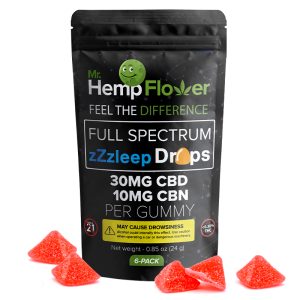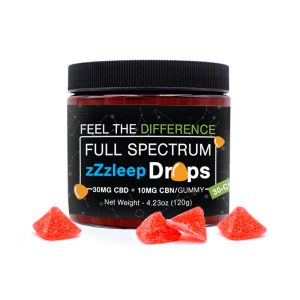Cannabinol CBN … What Is It Exactly? See Here

Cannabinol (CBN)
kan-ə-bī-nȯl | Noun
Cannabinol is the cannabinoid that tetrahydrocannabinol (THC) breaks down into after prolonged periods of time. Oxygen and heat may accelerate degradation. This cannabinoid is only mildly intoxicating, approximately one-fourth of the potency of THC.
“I’ve found that full spectrum CBN gummies are perfect for nights when I have trouble sleeping.”
“Did you know that old weed contains cannabinol, a cannabinoid with sedative properties.”
What Is Cannabinol?
A rare cannabis compound, known as the “sleepy” cannabinoid present in old weed. This compound is not in the top three most famous cannabinoids at the moment. However, those who know about CBN don’t sleep on it but use it to battle insomnia.
One of the reasons this cannabinoid is not being as celebrated as others is that it’s present in aged cannabis. The fact that it’s different from THC and CBD for its distinctive sedative qualities gives it a unique advantage.
Most of the studies around CBN’s effects, especially sedation, have been performed in rodents. A 1975 study revealed that this cannabinoid enhances the sedating effects of THC. The sedative effects of aged cannabis flower are not only caused by CBN. Aged cannabis loses lower molecular weight monoterpenoids in favor of sesquiterpenoids, which are more sedating. The sedative potential of this cannabinoid distinguishes it from cannabidiol (CBD), as the latter doesn’t cause sleepiness.
Is It Legal?
Like with other cannabinoids, CBN is not on the list of controlled substances in the United States. Therefore, its legality depends on where this compound is sourced from. If it’s derived from hemp, it’s completely legal. After the signing of the Agricultural Act in 2018, hemp (with 0.3% THC) and its compounds became legal federally. Therefore, when it’s derived from marijuana, this cannabinoid is legal in states where the cannabis plant is legal for recreational purposes.
How Does It Work?
An interesting aspect of this cannabinoid is that it acts on multiple pathways in the body, triggering various effects. Most cannabinoids, including CBD and THC, produce so many beneficial effects because they also activate multiple pathways in the body at once. These various mechanisms of action include channels that are separate from the CB1 and CB2 receptors. Research on this cannabinoid is in its infancy, and we still don’t know the exact pathways it activates in the body.
Benefits and Uses of CBN
This cannabinoid is a result of the degradation of THC, but it also offers new routes to exploring the use of medical cannabis. Despite being a lesser-known cannabinoid, it has some impressive potential medical uses, including:
Anti-inflammatory Effects
Almost all cannabinoids are effective anti-inflammatory molecules. CBN is not as widely used for its anti-inflammatory properties as THC or CBD, but that doesn’t mean it doesn’t help inflammation. A 2009 study that investigated cannabinoids as novel anti-inflammatory drugs revealed that cannabinol shows potential in the treatment of allergic asthma. This cannabinoid also shows potential in treating glaucoma by reducing inflammation that causes intraocular pressure.
Potent Sleep Aid
The primary value of this cannabinoid lies in its effectiveness as a sleep aid. An analysis from Steep Hill Labs shows that 5mg of CBN is as effective as 10mg of diazepam, one of the world’s main pharmaceutical sedatives.
Cannabinol is not only a potent insomnia medicine, but it’s easy to obtain because it’s available in various natural products on the market. If you have a hard time finding quality CBN products for sleep, consider our Full Spectrum CBN Gummies. Each gummy contains 7mg of CBN, and according to our customers… you only need half a gummy to fall and stay asleep.
Provides Pain Relief
Aside from being an effective sleep aid, CBN could also provide pain relief. Its pain-killing benefits potentially come from it being a weak CB1 agonist, aka it binds directly to the CB1 receptor of the endocannabinoid system. This means that it produces a much weaker effect compared to a full agonist, like THC. Cannabinol has been shown to produce around 10% of THC activity when acting on this receptor. Instead of alleviating pain by binding to the CB1 and CB2 receptors, this molecule also activates the alternative nerve mechanism by releasing peptides from sensory nerves.
Antibacterial Properties
Cannabinol is a highly effective antibacterial agent, one of several cannabinoids that have the potential to fight bacteria. One study tested its antibacterial effects on multiple antibiotic-resistant bacteria. The study found that this compound may be a viable option for reducing methicillin-resistant Staphylococcus aureus (MRSA) bacteria.
Potential Anticonvulsant
A 1974 study identified CBN as an effective treatment against convulsions. Like THC and CBD, this cannabinoid has the potential to reduce seizures and epileptic symptoms. It’s important to note that its anti-convulsive properties may be more effective when teamed up with CBD and THC, rather than an isolated compound.
Stimulates Bone Cell Growth
Aside from its uses as a potential agent for pain relief, inflammation, and appetite, CBN may also stimulate bone marrow cell growth. Research shows that this cannabinoid may be useful in creating bone tissue and healing bone fractures.
Stimulates Appetite
This cannabinoid may stimulate appetite. A 2012 study in rats revealed that CBN administration significantly increased the quantity and duration of feeding. These findings may indicate its potential use as another non-intoxicating alternative to THC as an appetite stimulant.
CBN vs. THC
An interesting study performed by the United Nations Office on Drugs and Crime (UNODC) in 1999 revealed the level of potency loss of cannabis over time. The study found that the potency of the THC content in the tested cannabis sample dropped to half after four years. It also noticed that as THC started to oxidize and dissipate, it started converting to CBN.
According to the study, the first two years of improper storage were critical for THC degradation. This means that THC degrades into this phytocannabinoid over time and cannabis becomes CBN-heavy as it ages. When labs show strains with high CBN concentration, it means that the strain has aged significantly. The ratio of these two cannabinoids could serve as a guide to determine the approximate age of a marijuana sample stored at room temperature.
Pharmacological History of CBN
Cannabinol was the first cannabinoid to be isolated in 1896. Thomas Barlow Wood, Thomas Hill Eastetrfield, and WT Newton Spivey isolated the phytocannabinoid from a red oil cannabis extract. In 1932, R.S. Cahn clarified its chemical structure, which paved the way for its chemical synthesis and official discovery by two research groups in 1940 — R. Adams in the U.S. and Lord Todd in the UK.
After its official discovery in 1940, researchers considered it the primary psychotropic compound of cannabis for over two decades. The truth came to light when Israeli researchers Gaoni and Mechoulam isolated THC in 1964 and discovered its psychotropic dominance within the cannabis plant. Further research revealed the true nature of this cannabinoid, as researchers identified it as the oxidized, degraded version of THC without the intoxicating effects.
The sedative effects of CBN need further investigation. There is the theory that the terpenoid profile may contribute to the sedative effects of aged cannabis as much as THC degradation. If you’ve ever used a CBN product, it probably hasn’t contained this cannabinoid as an isolated compound. Most products are a combination of CBN with THC, CBD, and even terpenes. Science shows that this combination may be giving the sedating effects, rather than CBN itself.
Research shows that as an isolated compound, CBN was an “inactive cannabinoid.” One 1976 study investigated the effects of this phytocannabinoid together with THC and as an isolated form. When given to people as an isolated compound, cannabinol wasn’t sedating. But, when combined with THC, it produced greater sedation even when compared to THC alone. So, the combination of compounds may be responsible for the sedation, not CBN itself.
Where to Buy CBN?
If you are interested in a non-intoxicating alternative to THC for medicinal purposes, CBN might be your cannabinoid. If you are living in a state where marijuana is illegal, it’s unlikely that you’ll find a cultivar that’s heavy in this phytocannabinoid (old weed).
Since hemp-derived CBN is legal, you will find products that contain this cannabinoid. People are becoming aware of minor phytocannabinoids’ benefits, so manufacturers have started to include this cannabinoid in oils, tinctures, capsules, and topicals.
According to anecdotal evidence, this cannabinoid produces more potent sedating effects when taken with food. This is why you need to try our Full Spectrum CBN Gummies. They are a sugar-free product, an improved formula that combines over 40mg of CBD and 7mg of CBN. Made with full spectrum oil, they are rich in terpenes, which is the combo you need to wind down and have a good night’s sleep.
Final Thoughts
Cannabinol is a phytocannabinoid created from the degradation of THC. It’s non-to-mildly intoxicating and offers unique therapeutic benefits.


